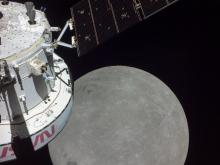Listen to today's episode of StarDate on the web the same day it airs in high-quality streaming audio without any extra ads or announcements. Choose a $8 one-month pass, or listen every day for a year for just $30.
You are here
Going Nuclear
Three spacecraft arrived at Mars last month. It took them almost seven months to get there. But there may be a faster way to reach Mars in the decades ahead — especially for missions that carry people: spaceships powered by nuclear engines.
NASA and other agencies studied nuclear engines for a couple of decades. They built test models, and were ready to build an engine to fly in space when the project shut down, in the 1970s. But there’s been renewed interest in recent years. In 2019, NASA received $125 million to study the technology again.
Nuclear thermal propulsion would use a small amount of uranium to heat the engine’s fuel — probably liquid hydrogen. The hydrogen would expand and shoot out into space through a rocket nozzle. Improvements since earlier testing could make it possible to use a less-enriched form of uranium, which would be safer and easier to handle.
Such an engine could be two or three times more efficient than a chemical engine, which powers today’s rockets. That could cut travel times to Mars and other planets. And it could provide other benefits as well, as promised in this NASA promotional film from the ’60s:
AUDIO: Lower overall weight. Larger payloads. Shorter travel time. These are the chief advantages of nuclear propulsion. The technology needed to build a nuclear rocket is well advanced. It will be available when this nation determines its next great objective in space.
Script by Damond Benningfield





